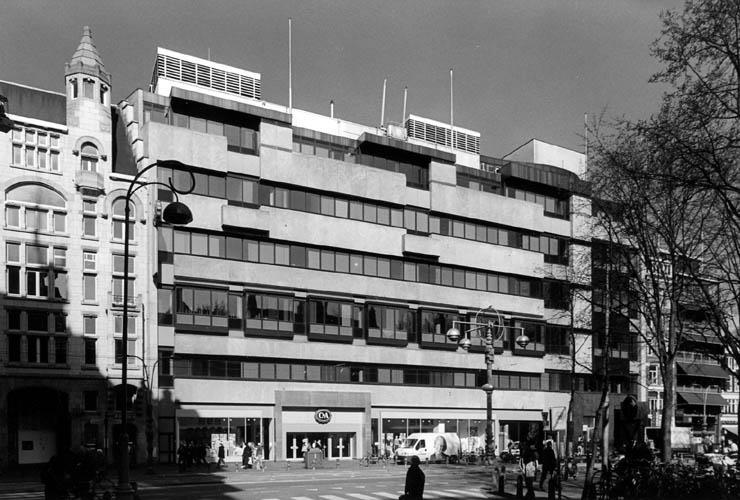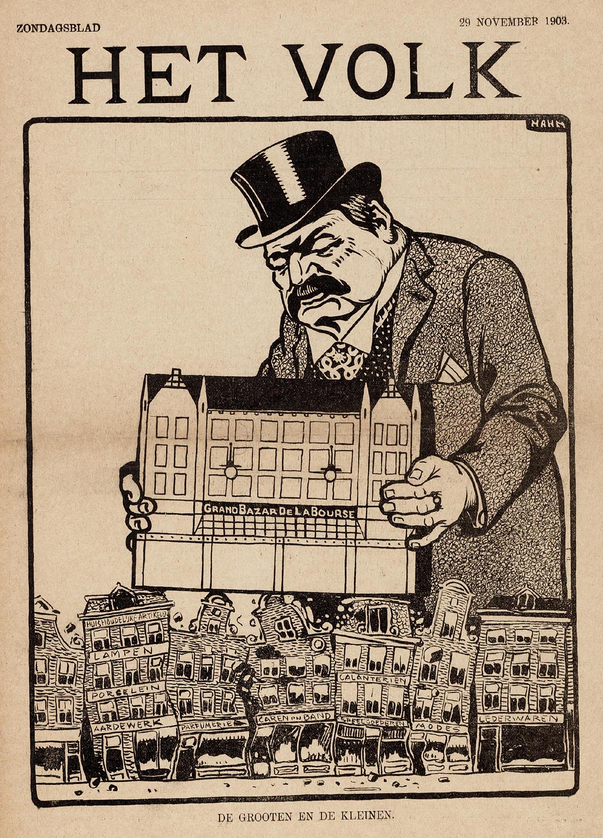Amsterdam’s Damrak and Rokin thoroughfares are currently experiencing an unprecedented redevelopment boom. Despite the recession, steel scaffoldings cover several office blocks, hotels and shopping venues – with much more to come. Soon the redevelopment and demolition of some of the inner city’s largest office buildings will commence. Amongst them is the modernist C&A complex at Damrak 70, about which Failed Architecture organised a debate on the 23rd of June.

Damrak 70 will be redeveloped to such an extent that nothing apart from its construction skeleton will remain standing. The existing concrete premises will be stripped back to make way for new brick façades, which according to the architects involved will fit better into the surroundings. Currently small creative firms and freelancers occupy the floors above the C&A department store – not a profitable business for real estate manager Bouwinvest. The investor therefore asked Top Real Estate to comprehensively redevelop the premises, bringing more than 20.000 square metre of newly built shopping space to Amsterdam. Late last year, Robert Stern and Rijnboutt Architects presented their design for the Damrak façade and an adjacent building at Nieuwendijk. While most Amsterdammers consider the C&A complex a concrete eyesore, others mourn the loss of yet another piece of modernism.
During the debate on the 23rd of June, led by architectural critic and journalist Tracy Metz, we discussed the building’s aesthetics and the dynamics that have kickstarted the current redevelopment scheme together with Frederik Vermeesch, (Rijnboutt Architects), Patrick van Lammeren (TOP Real Estate), Boudewijn Oranje (portfolio holder ‘living and working’ for Amsterdam’s inner city) and Leen Eelman (Bond Heemschut).
Vermeesch was rather business-like about the building’s prospective: ‘We just put a new façade in front. If the people dislike our design in half a century from now, they can tear it down as well if they wish.’ Van Lammeren shared Vermeesch’s views: ‘The C&A building was an assault on Amsterdam. They just dropped a Rotterdam-like lump of concrete on the inner city. By doing so C&A took a part of Amsterdam, which we will give back.’
 Damrak 70 after redevelopment.
Damrak 70 after redevelopment.
As a preservationist, Eelman was quite happy to see the ‘lump of concrete’ disappear from Amsterdam’s Damrak: ‘The building does have some nice qualities, but not at this location. Its meaningless, abstract forms don’t have anything to do with its function.’ Tracy Metz interrupted by stating that good urban design can handle bad architecture. The Damrak is a jumble of architectural styles, why can’t we have ‘ugly’ sitting next to ‘beautiful’ just as we can still love that cousin with protruding ears? Vermeesch: ‘I like modernist architecture too, but the problem is that it usually doesn’t take into account the environs in which it’s built.’ He defended the new traditionalist design by saying that ‘it’s nonsense to think you can only be modern by designing modernist architecture’, and that it’s perfectly possible for architects to talk about good and bad aesthetic design.
As a developer, Van Lammeren focuses much more on the building’s function rather than its design (i.e. can one still make money out of this site?). Van Lammeren: ‘The building as it is doesn’t work anymore and it’s not an icon worth saving. Its office floors need to be transformed into shopping space, that’s what Amsterdam needs.’ The developer is not afraid online shopping might threaten revenues: ‘There’s a lot of shop vacancy in the Netherlands, except for the old inner cities. These remain attractive shopping areas in which first class retailers such as Primark can still make a profit. We considered transforming the building into a hotel or apartments, but this turned out be less profitable for the pension fund that owns the building.’
A ‘brutal assault’ on the inner city?
A topic of debate was the scale of Damrak 70, which according to Vermeesch and Van Lammeren was too big to fit into the adjoining line of facades. A young member of the audience dully noticed the palace on Dam square is not really fitting its environs either, stating that there might be a generation clash in our assessment of architecture. The young generation that now makes temporary use of modernist buildings such as Post CS (already demolished), Trouw (threatened by demolition) and Duintjer CS (undergoing redevelopment) is becoming less negative about this typology, mainly because these are the places where they live, work and go out nowadays.
In defense, Vermeesch found an interesting explanation for the building’s demise and the opposition by younger members in the audience: ‘It’s a fine example of the Oedipus complex: a generation always tries to get rid of what the generation before them built and re-evaluates the built legacy of their grandparents. Maybe that’s what’s going on here.’ According to Vermeesch, architects should be more responsive to what the people want, and in general that’s not overwhelming modernism: ‘We are not part of some elite any more.’ Oranje stated the inner city should not be cleansed of all modernist architecture: ‘A city that doesn’t pay respect to its history, how close it may still be, is a disgrace. We should transform the city to modern-day standards, but at the same time keep images and ideas from different architectural era’s intact as well.’
During Failed Architecture’s very first event, the American architectural critic and preservationist Anthony Tung talked about ‘fitting’ architecture and recent Amsterdam examples of so-called fill-in architecture. We asked him about his thoughts on this redevelopment scheme. Tung: ‘During the post-war period, many historic inner cities were fractured by large modern structures of incompatible size, form, and materials.’ Tung thinks the C&A building is ‘not only brutalist in its forms, it is also brutal in the way it relates to its surroundings.
However, one could just as well say that if there is one street in Amsterdam where buildings not suit each other in style and size, it is Damrak. Moreover, the former C&A department store, which burnt down in 1963, was also regarded as an assault on Amsterdam’s inner city when it was completed in 1893. Maybe the modernist building just needed some more time.
 A political cartoon from 1908 criticizing large scale redevelopment projects.
A political cartoon from 1908 criticizing large scale redevelopment projects.
A small piece of Thailand in Amsterdam
Of course, there is much more at stake here than just taste and aesthetics. The recent redevelopment boom alongside Amsterdam’s inner city main thoroughfares is partially due to municipal policy. Firstly, a new metro line is being dug on site, connecting the North of Amsterdam to the South. This improved accessibility has resulted in a run on sustainable office space near the future metro stops. Secondly, the redevelopment projects neatly fit into the municipality’s aim to make Damrak and Rokin into a more ‘welcoming entrance’ to Amsterdam. Locals’ associations with Damrak leave much to be desired, with people calling it a ‘snack stall’ or ‘sex and souvenirs boulevard’, and even ‘the ugliest spot in Amsterdam’.
Patrick van Lammeren shares these opinions, comparing the Damrak to a ‘street lined with neon lights in Thailand.’ By giving Damrak 70 a new appearance, the building will not only ‘fit’ better into its surroundings, but will also better suit the demands and wishes of the crowds Amsterdam’s municipality hopes to attract. Policy makers hope to lure more large retailers to the city, in which they seem to succeed now that Primark will rent most of the shopping space in the redevelopment project.
 Damrak. Image by donnamarijne.
Damrak. Image by donnamarijne.
Therefore, Oranje is quite positive about the future of Damrak 70: ‘Amsterdam’s inner city will become even stronger with the coming of first class retailers. Their redevelopment schemes will open up the formerly closed ground levels of post-war office developments.’ The municipal representative was quite straightforward about the economically weaker functions in the inner city: ‘We should get rid of the exchange offices, tourist shops and prostitution-related commerce in this area. We accept the growth of tourism, but not the negative side effects.’
Oranje’s statements demonstrate just how closely related architecture and politics are in a city that is experiencing one of the biggest development booms since the Second World War. Amsterdam’s inner city is turning into a safe haven for day trippers and tourists, an economic development that is eagerly encouraged by municipal policy. Abiding to what architects, developers and politicians think of what these people want, the city’s central area is architecturally, economically and socially being cleansed of less desirable elements. The redevelopment of Damrak 70 is a concrete example of how Amsterdam’s success as an entrepreneurial city literally influences the urban fabric.
Underneath you will find a video registration of the debate that took place on the 23rd of June (in Dutch).
FA#11: A Brutal(ist) Assault on Amsterdam’s Inner City?
Tim Verlaan
FA #11 focused on a modernist building that will be redeveloped, showing how Amsterdam's centre is architecturally, economically and socially cleansed of less desirable elements.
share this article
Wednesday 3 July 2013
/
Uncategorized
add comment